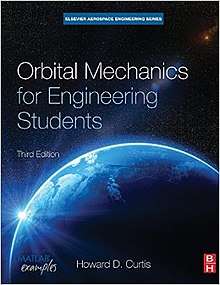Orbital Mechanics for Engineering Students
Orbital Mechanics for Engineering Students is an aerospace engineering textbook by Howard D. Curtis, in its fourth edition as of 2019.[1] The book provides an introduction to orbital mechanics, while assuming an undergraduate-level background in physics, rigid body dynamics, differential equations, and linear algebra.[2][3]
 Third edition | |
| Author | Howard D. Curtis |
|---|---|
| Series | Elsevier Aerospace Engineering Series |
| Subject | Orbital mechanics |
| Published | 2010 (Butterworth-Heinemann) |
| Pages | 792 (4th ed.) |
| ISBN | 978-0-08-102133-0 (4th ed.) |
Topics covered by the text include a review of kinematics and Newtonian dynamics, the two-body problem, Kepler's laws of planetary motion, orbit determination, orbital maneuvers, relative motion and rendezvous, and interplanetary trajectories.[3] The text focuses primarily on orbital mechanics, but also includes material on rigid body dynamics, rocket vehicle dynamics, and attitude control.[2][3] Control theory and spacecraft control systems are less thoroughly covered.[3]
The textbook includes exercises at the end of each chapter, and supplemental material is available online, including MATLAB code for orbital mechanics projects.[2]
References
- Curtis, Howard D. (2019). Orbital Mechanics for Engineering Students (4th ed.). Butterworth-Heinemann. ISBN 978-0-08-102133-0.
- Hall, Christopher; Sandfry, Ralph A. (March 2008). "Review of Orbital Mechanics for Engineering Students". Journal of Guidance, Control, and Dynamics. 31 (2): 445–446. Bibcode:2008JGCD...31..445H. doi:10.2514/1.34514.
- Jablonski, Alexander M. (June 2005). "Book Review: Orbital Mechanics for Engineering Students". Canadian Aeronautics and Space Journal. 51 (2): 87. Bibcode:2005CaASJ..51...87J. doi:10.5589/q05-005.